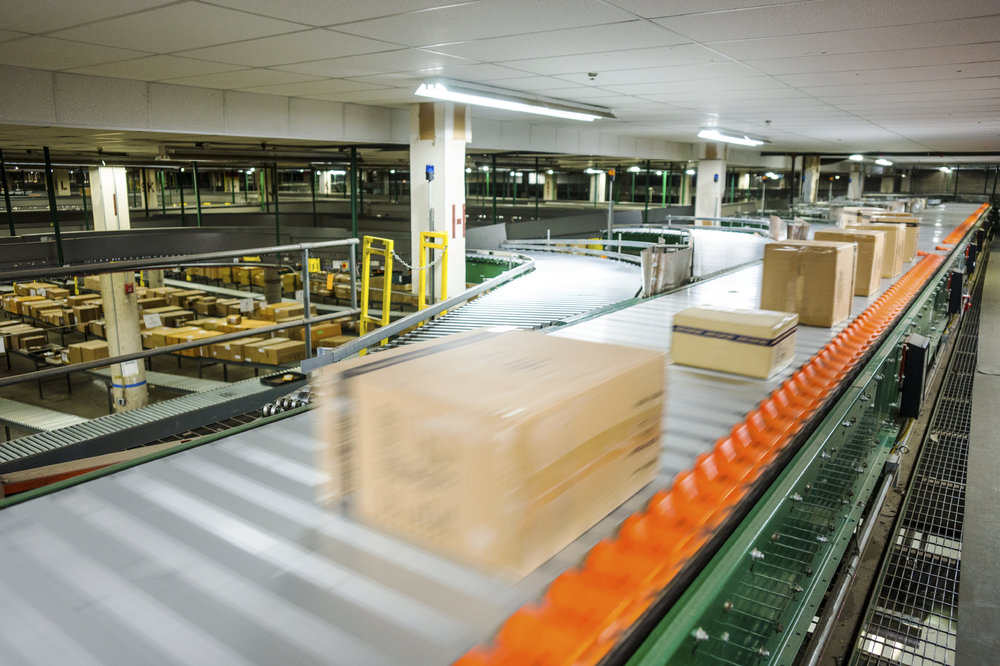Wasp Barcode Technologies: The Barcode Solution People
4 Concerns for Today’s Distribution Center

The extraordinary growth of online shopping has presented unique challenges for today’s distribution centers. As the average customer demands a seamless experience from your business, from their smartphone, a catalog, their laptop, to shopping at your brick and mortar store, omnichannel issues have
pushed deeper into a company’s supply chain, forcing business owners to re-examine their distribution center operations.
While warehouses may have normally fulfilled five thousand orders a day, they could now be expected to fulfill 50 thousand orders a day, and do it faster than ever. This can overwhelm its current capabilities.

In response, there are specific concerns your distribution center should proactively address to keep up in today’s marketplace.
Increased Customer Demands
If you’ve been in a distribution-intensive business for some time, you’ve likely grown more customized and complex. Your distribution center might be based on larger orders, longer lead times and less frequent shipments. Thanks to e-commerce and the rapid growth of omnichanneling, the face of distribution is changing. Customers tend to make smaller orders more frequently, with demands for shorter delivery times.
[su_divider top="no" size="2"]
[su_divider top="no" size="2"]
If possible, running a warehouse facility closer to your customers can allow you to leverage inventory in new, better ways. If your goal is to speed up delivery times, localized distribution centers give you a competitive advantage, making it possible to offer same day or next day delivery.
If you run a small business or a start-up, multiple distribution centers may not be on the radar now. You can look within your four walls for solutions. For example, it’s important to streamline operations through processes as simple as creating
customer-specific labels. An
inventory management system enables you to more easily take care of your regular customers in this way. It’s a waste of time to create a new label every time to ship to a certain customer. So having a built-in labeling system, which recognizes each customer’s preferences, will not only get the right order shipped to the right client but also make it much easier for workers. They will always be dealing with correct labels every time, minimizing order and shipping errors.

Growth of Multichannel Distribution
It might be more efficient to run a single channel warehouse, but in today’s market, it’s very limiting. Customers have more ways to buy from your company, from mobile sources and in-store, so your facility needs to be planned accordingly. The rise of ecommerce and other channels has companies looking for new design ideas in order to leverage distribution space and organizational overhead. It’s becoming more common for wholesale, retail, and ecommerce to be housed in the same facility. Companies should take advantage of the opportunity to reduce overall inventory levels through leveraging inventory and funneling it through each channel when needed.
Adaptation to Changing Peak Times
Business needs evolve rapidly, and you need to be prepared when the next wave of growth comes, because it will come.
[Tweet "Business needs evolve rapidly."]
“In the past, we had seasonal peaks, like back to school or the start of the year when businesses have new budgets,”
Bill Stark, vice president of engineering at United Stationers, said in an
article on Supply Chain 247. “You’d see a 25 percent bump for a few days or weeks, and then it would taper down to average.”
Seasonal peaks are predictable and relatively easier to plan for, hiring more employees, adding shifts, or keeping popular items in stock during that time. Plus, automated inventory control supplies real-time inventory data as well as accurate historical data from prior seasons. Now, Stark explained that peak times can change by the hour.
“People go on the Internet when they get home from work,” Stark added. “In the morning, we have a slew of orders that came in overnight. Meanwhile, I’m likely to get a bunch of orders between 3 p.m. and 6 p.m. that have to get picked to meet the UPS cut-off time.”
As a result, businesses quickly become completely overwhelmed by the much higher demands. So your facility should be designed with growth in mind, staying open to future changes that could be right around the corner.
To avoid getting overcome by these changes, you’ll want to keep particular things in mind, such as rationalizing and right-sizing how much automation is used or how space is utilized within your distribution center. Today’s complex multichannel environment must be designed for maximum flexibility, starting with averages with the ability to scale easily and quickly to adjust to shifts in peak volumes over time. It’s the only way to survive in today’s marketplace.
Further, to design for peak, an
automated picking engine is also recommended to handle everyday demand. This could include the use of a cross-belt sorter or goods-to-person picking solution, enhanced by an automated solution to handle peak demand.
Product Data Accuracy
As a small business owner,
access to accurate data is vital because it will help your employees be more productive and enable management make more informed decisions for the future. The first step towards accuracy is taking control of your inventory with an automated system. The
2016 State of Small Business Report found that
48 percent of small businesses don’t track inventory at all or use manual tracking methods like pen and paper or spreadsheets. If this sounds like your company, then you can forget accuracy. An automated inventory management system will not only
eliminate human error that happens often with manual methods, but offers analytical tools available to help marry product dimensional data with detailed order volume history and inventory.
[Tweet "48 percent of small businesses don’t track inventory at all."]
Solid product dimensional data might seem like old news to you, but its importance for distribution centers has grown. Operational efficiency and inventory accuracy significantly decrease when product dimensional data is incorrect. Even more so, product weight and dimensional data take on more importance in distribution design. When planning storage for products with a wide variety of storage and handling needs, accurate dimensional data is necessary to operate a labor-efficient space.
Your warehouse is the lifeblood of your business. Don’t be surprised by the ever-changing demands in today’s retail culture, but stay abreast of them and proactively adjust to make your business stronger.
What distribution center issues concern your business?





